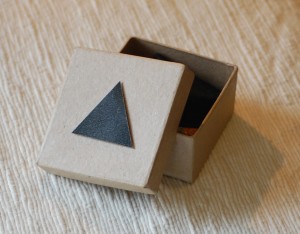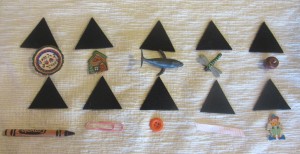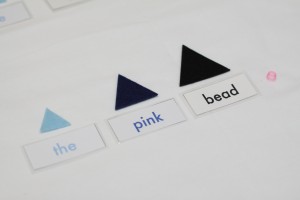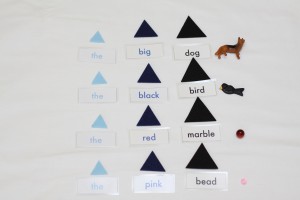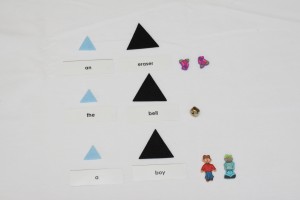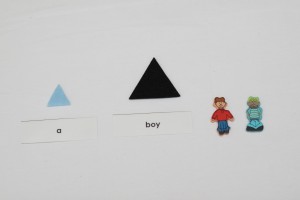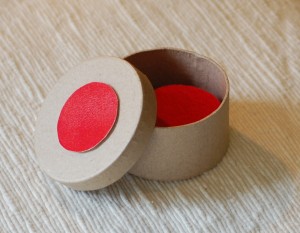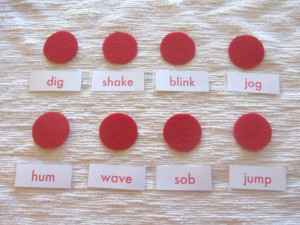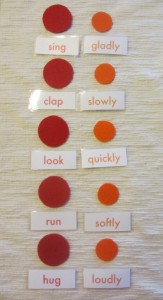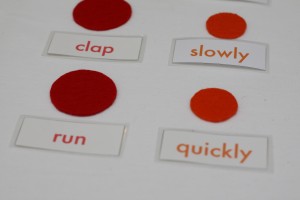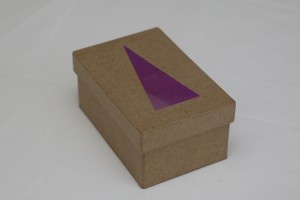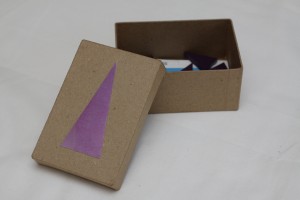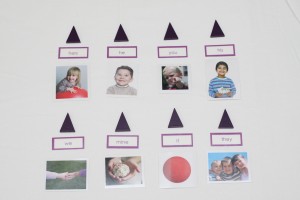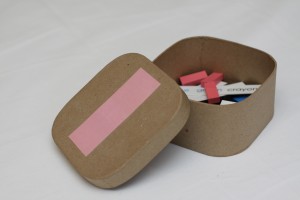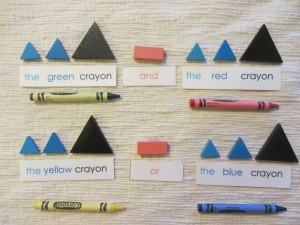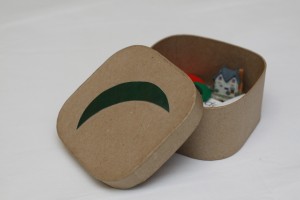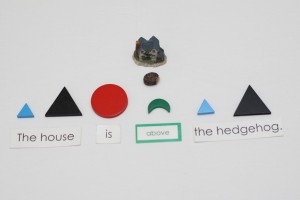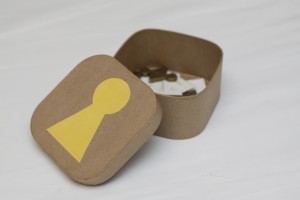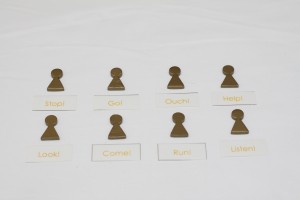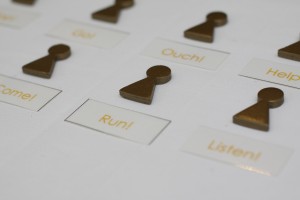A great extension for grammar studies is the Grammar Symbol Boxes. They are fun and easy to make, and children love them! You can start small and make the Noun, Article, and Adjective Boxes first. Then you can add Verb and Adverb, and later add the rest of the parts of speech. Or, if you’re ambitious, you can make all 9 at one time!
The boxes I am showing you are ones I have made over several years. Yours do not have to match exactly. Contents will differ based on the objects you have available and the interests of the children you’re teaching. My boxes are based on objects I had on hand around my house and ones I found at craft stores. For the grammar symbols in each box, I started by cutting them out of felt, then I ended up using wooden symbols from a set I bought online. The labels were made here and there as I needed them, so they vary in size.
These boxes can used as the initial lesson for each part of speech, or they can be an extension if the child has already learned the parts of speech. For each box, the child should write or draw something on their paper after matching the symbols, objects, and/or labels appropriately. Control of use is usually a teacher or an older student.
To make a complete set of all 9 parts of speech, you will need (this list can be downloaded as a PDF at the end of this post):
Nine boxes—can be cardboard, wood, or other container. Check craft stores, teacher stores, or the Container Store for boxes. Each box needs to be big enough to hold labels, grammar symbols, and in most cases, small objects.
About 40 small objects—Many small objects can be found around your home or school; www.montessoriservices.com is a good source for objects, as well as craft and teacher stores. If the list below doesn’t make sense, keep reading! I explain each box in detail and how the objects are used in each box. Specifically, you will need:
1) Noun Box: 10 small objects (nouns)
2) Adjective Box: 5 pairs of different colored objects (buttons in two colors, marbles in two colors, etc.)
3) Article Box: identical doubles of two objects that start with a vowel sound (apple, eraser), as well as at least 4 sets of identical doubles
4) Verb Box: No objects
5) Adverb Box: No objects
6) Pronoun Box: If desired (optional), pictures of people and objects that can be referred to by various pronouns
7) Conjunction Box: Four crayons of different colors or 4 other identical objects in four different colors
8) Preposition Box: At least 4 very different objects, to be used in combination with each other
9) Interjection Box: No objects
Grammar Symbols — You will need quite a few of each symbol: at least 30 black triangles for nouns, 20 articles, 20 adjectives, 12 verbs, 6 adverbs, 4 conjunctions, and as many prepositions and interjections as you have labels. These numbers are approximate because it will depend on how many objects you put in the boxes.
You will also need one grammar symbol to put on the top of each box. If you want these to be larger, you can cut them out of colored paper or cardstock and laminate, then glue or tape them to the top of the boxes.
For Grammar Symbols, there are a few different routes you can take. You can buy a Grammar Symbols PDF and print, laminate, and cut. This way you can print as many as you need for your boxes.
There are also paper and wood sets available from various Montessori companies. You can also cut them out of felt. I used a combination of felt and wood symbols in my boxes.
Labels — Some of the parts of speech (verb, adverb, interjection) use only labels and no objects. The noun box typically uses objects and no labels. The other boxes use a combination of objects and labels. It’s perfectly fine to hand-write labels for these boxes, or make them on the computer. I use Century Gothic font for mine. Many of the cards in our Grammar Cards Set can be used with these boxes, and have colored outlines to match the color of the symbol, but our Grammar Cards Set is definitely not an exact match for Grammar Symbol Boxes.
Pictures — My daughter is the one who had the idea to use pictures in the Pronoun Box. We found a variety of pictures of children (together or separately) and objects to use with the pronouns. Many times more than one pronoun will work with a picture. These are optional – you could use only labels and symbols in this box.
The Noun Box
Find a box that can hold small objects, and glue a black triangle to it. Triangles inside the box can be made of wood (from a wooden grammar symbol set), felt, cardstock, or cardboard. Objects can probably be found around your home or school. I like to use 10 objects/triangles in this set. You do not need labels for the objects. Click on all pictures to enlarge:
The Adjective Box
You will put a medium dark blue triangle on this box. You will need 5 objects, of two different colors each. You will need labels for articles (use “the” for each), adjectives (the colors of each object), and nouns (the name of each object). Some suggestions include:
2 different colored buttons
2 different colored marbles
2 different colored beads
2 different colored animals
2 different colored paper clips
The Article Box
You will need a small box with a small light blue article triangle on it, and small light blue article triangles and black noun triangles to put with the objects.
Funnily enough, there are fewer articles than any other part of speech (a, an, the) but this box is a very difficult one because of the difference between definite and indefinite articles. In order to use the “an” (used before a word that starts with a vowel sound), you will need at least one type of object that starts with a vowel sound (apple, eraser).
In order to show the difference between definite and indefinite articles, you will need multiples of some of the objects.
One suggestion is:
2 bells — a bell (you have to choose from between the two bells; Say to the child “Give me a bell”. Either bell will do.)
2 small blocks — a block (you have to choose from between the two, same as above)
2 small erasers— an eraser (you have to choose from between the two, same as above)
2 miniature apples — an apple (you have to choose between the two, same as above)
1 miniature book — the book (there is only one book)
1 small button — the button (there is only one button)
The Verb Box
This box needs to have a red circle on it. If you can find a circular box, that would be great.
This box deliberately does not have objects, as to reinforce to the child that a noun is a “thing” that you can touch, hold, or see, but a verb is an “action” that can be done. I recommend between 6-10 red circles and verb cards.
The Adverb Box
This box also deliberately does not have objects, as to reinforce to the child that a noun is a “thing” that you can touch, hold, or see, but that an adverb modifies a verb, which you can not touch or hold.
I recommend between 6-10 adverb and verb combinations, and their corresponding symbols.
The Pronoun Box
Originally I made this box with only symbols and labels; my daughter was the one who came up with the idea of including pictures to represent the various pronouns and I tried it and loved it. Of course you do not have to use the pictures if you don’t want to, you could use only symbols and labels. I recommend between 6-10 pronouns with labels or labels with pictures.
Conjunction Box
I have often seen conjunction work with small vases and colored flowers. Montessori Services sells a set like that. I love that idea, but I found that this was less expensive and took up less room, so I like the idea of crayons. Of course you can find 4 different objects if you don’t want to use crayons. You can see that I used wooden grammar symbols for this box.
For this box, I used crayons in 4 different colors (you can choose another simple, common object in 4 colors); you’ll need symbols for articles, adjectives, nouns, and conjunctions. Cards should match the object and color names.
The Preposition Box
I find it best to use complete sentences for this work. So, you will need two labels for each object — one with the first word capitalized, to be the beginning of the sentence, (“The house”, in the picture below), and one in lowercase with a period at the end, to be the end of the sentence (“the hedgehog.”). The label “is” can be used as the verb in each sentence, so make a few of those.
Children can mix and match the objects in various configurations (2 at a time), and start the sentence with either of the two objects as they desire. For this box, you will need at least 4 very different objects, symbols for article, noun, verb (use “is” for each sentence), and preposition. Labels for each object, several for “is”, and a variety of prepositions to choose from.
The Interjection Box
This box is very straightforward: interjections are their own sentences! They can also be used at the beginning of a sentence with a comma after for less effect. You do not need objects for this box.
For this box, you will need conjunction symbols and conjunction cards. You can have as many as you like; I think 8 of each is a good amount.
Helpful Resources:
PDF Download: Grammar_Symbol_Boxes_Instructions.pdf. This 2-page PDF has a list (taken from the top of the post) of everything you need to make all 9 boxes, plus a second page with pictures of the contents of each box. Easy to print and take with you to the store.
Blog Posts:
Grammar, What Is It Good For?
Introducing Grammar with Games and Activities – this post is basically a step-by-step guide to using the grammar boxes to introduce the parts of speech
Grammar Materials Bring Language to Life
Doubling Your Grammar Materials with Simple Extensions
PDFs available for purchase and instant download:
Grammar Charts and Symbols – the symbols in this set can be printed, laminated, and used on top of and in the grammar boxes.
Grammar Cards Set – the cards in this set (18 cards for each part of speech) can be used in the Grammar Symbol Boxes. They do not coordinate with what I show in this post – I made separate cards for my boxes – and you would not find every card you need in this set (especially to go with the objects you put in the boxes, although the noun cards do include common household objects) but you would be able to use many of the cards for the boxes, and they have a colored border to match the color of the grammar symbol.

